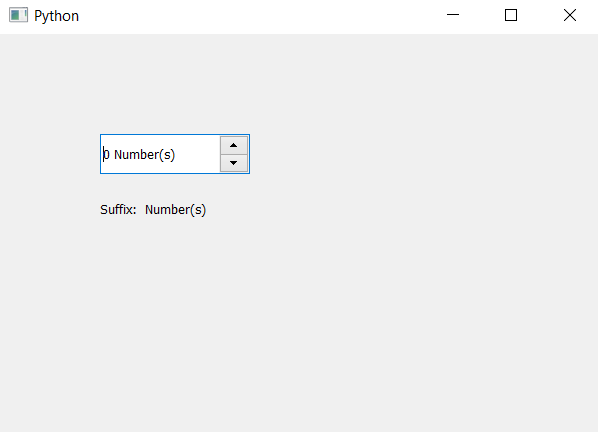En este artículo veremos cómo podemos acceder al sufijo del cuadro de número, el sufijo es el texto adicional agregado al final del valor, no es editable y es permanente. De forma predeterminada, no hay un sufijo establecido en el cuadro de número, aunque podemos establecer el sufijo en cualquier momento con la ayuda del setSuffixmétodo.
Para ello utilizaremos suffixel método.
Sintaxis: spin_box.suffix()
Argumento: no requiere argumento
Retorno: Devuelve string
Pasos para la implementación:
1. Cree un cuadro de número
2. Establezca el sufijo con la ayuda del método setSuffix
3. Cree una etiqueta para mostrar el sufijo
4. Obtenga el sufijo con la ayuda del método sufijo
5. Muestre el sufijo a través de la etiqueta
A continuación se muestra la implementación.
# importing libraries
from PyQt5.QtWidgets import *
from PyQt5 import QtCore, QtGui
from PyQt5.QtGui import *
from PyQt5.QtCore import *
import sys
class Window(QMainWindow):
def __init__(self):
super().__init__()
# setting title
self.setWindowTitle("Python ")
# setting geometry
self.setGeometry(100, 100, 600, 400)
# calling method
self.UiComponents()
# showing all the widgets
self.show()
# method for widgets
def UiComponents(self):
# creating spin box
self.spin = QSpinBox(self)
# setting geometry to spin box
self.spin.setGeometry(100, 100, 150, 40)
# setting step type
self.spin.setSuffix(" Number(s)")
# creating label
label = QLabel(self)
# setting geometry to the label
label.setGeometry(100, 160, 200, 30)
# getting suffix
suffix = self.spin.suffix()
# setting text to the label
label.setText("Suffix: " + suffix)
# create pyqt5 app
App = QApplication(sys.argv)
# create the instance of our Window
window = Window()
# start the app
sys.exit(App.exec())
Producción :
Publicación traducida automáticamente
Artículo escrito por rakshitarora y traducido por Barcelona Geeks. The original can be accessed here. Licence: CCBY-SA